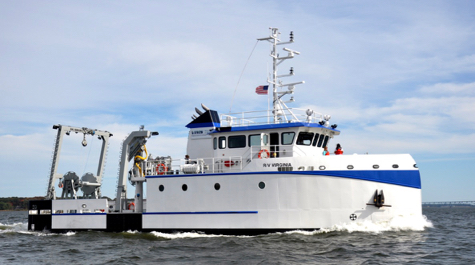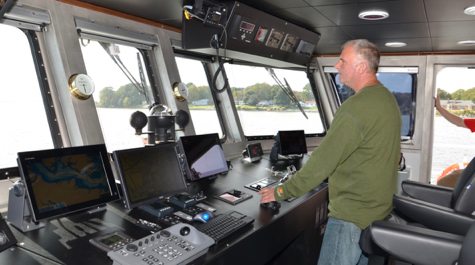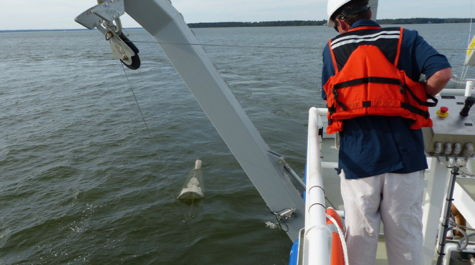VIMS welcomes new research vessel
93-foot R/V Virginia enhances Bay science, extends research footprint offshore
The Virginia Institute of Marine Science community officially welcomed its new flagship research vessel—the R/V Virginia—at the Yorktown waterfront today. The public christening of the vessel is scheduled for April of 2019.
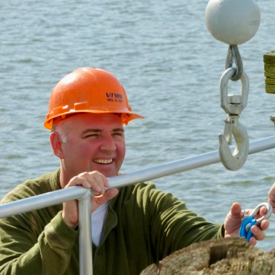 “This is a new day in marine research opportunities for VIMS,” says Dean and Director John Wells. “The Virginia is the most modern, most capable research vessel in its size class anywhere in the U.S., and will greatly increase our ability to serve the citizens of the Commonwealth and maritime stakeholders on both local and regional scales.”
“This is a new day in marine research opportunities for VIMS,” says Dean and Director John Wells. “The Virginia is the most modern, most capable research vessel in its size class anywhere in the U.S., and will greatly increase our ability to serve the citizens of the Commonwealth and maritime stakeholders on both local and regional scales.”
The 93-foot vessel will allow VIMS scientists to monitor and study the Chesapeake Bay and its marine life much more effectively, and expand the institute’s research footprint into the open waters of the coastal Atlantic from Maine to Florida.
Dr. Mark Luckenbach, Associate Dean of Research and Advisory Services at VIMS, says “First and foremost, the Virginia provides a much improved platform for our fisheries surveys, which are the foundation for the management of recreational and commercial fisheries not only in Bay waters but for species up and down the East Coast.”
Indeed, the new vessel will for the first time allow VIMS researchers to match the geographic range of the fishes they study, many of which use the Chesapeake as a summertime nursery and feeding ground while migrating offshore onto the continental shelf at other times of the year. The Virginia will support VIMS’ Multispecies Fisheries Research Program and the Virginia Shark Monitoring and Assessment Program, among others.
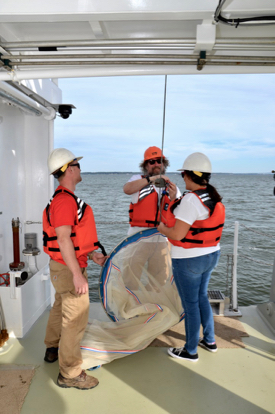 In addition to its fisheries capabilities, the vessel has the equipment required to perform bathometric and seismic surveys, deep-water plankton surveys, and coring operations. Its stern- and side-mounted cranes facilitate deployment of trawl nets and dredges, scientific buoys, and the new generation of robotic vehicles, both tethered (ROVs) and untethered (AUVs).
In addition to its fisheries capabilities, the vessel has the equipment required to perform bathometric and seismic surveys, deep-water plankton surveys, and coring operations. Its stern- and side-mounted cranes facilitate deployment of trawl nets and dredges, scientific buoys, and the new generation of robotic vehicles, both tethered (ROVs) and untethered (AUVs).
“No other vessel can provide the deck gear, the geophysical capabilities, and the coring capabilities of the Virginia,” says Wells. “It’s got the flexibility to do almost anything on the water that any of our scientists might want to do to increase understanding, now or in the future.”
{{youtube:medium|qMxFeKiwulw, Watch as the R/V Virginia plies the waters of the Chesapeake Bay. © D. Gong/VIMS.}}A state-of-the-art platform for improved science and management
Durand Ward, VIMS marine superintendent, describes a number of ways in which the Virginia provides an improved research platform. “The vessel has a large working deck, ample lab space, and much more comfortable berths” he says. “These will allow our scientists and crew to work more safely, and under harsher conditions, while staying at sea for longer stretches.”
The vessel’s lab space—500 square feet in total—is divided into a wet lab for processing samples within a protected area, and a dry lab for conducting experiments with sensitive instruments while underway. Its electrical and networking systems were designed to handle the torrents of data collected by today’s high-tech field sensors and lab instruments, and with an eye to the even more voluminous data streams expected for the future.
These features, along with the vessel’s engine and propulsion systems, combine to allow the vessel to operate more efficiently in terms of both fuel and cost.
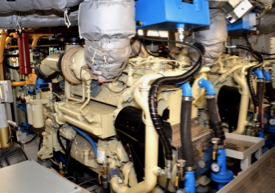 “You don’t have to come back in every few days to refresh and refuel,” says Luckenbach. “You can get farther up the Bay, and farther offshore with fewer port calls.” Adds Ward, “the Virginia’s power plant—two Cummins QSK19-M diesels—will allow the vessel to operate most times with just one engine, allowing for huge fuel savings.”
“You don’t have to come back in every few days to refresh and refuel,” says Luckenbach. “You can get farther up the Bay, and farther offshore with fewer port calls.” Adds Ward, “the Virginia’s power plant—two Cummins QSK19-M diesels—will allow the vessel to operate most times with just one engine, allowing for huge fuel savings.”
The vessel’s captain, John Olney, Jr., touts the vessel’s dynamic positioning system, which uses an omni-directional bow thruster, triple rudders, and a controllable pitch propeller to hold the Virginia within a meter of its intended location under all but the harshest conditions. That’s crucial for coring of geological samples, and for the safe and effective deployment and retrieval of dredge and trawl nets used in fisheries surveys.
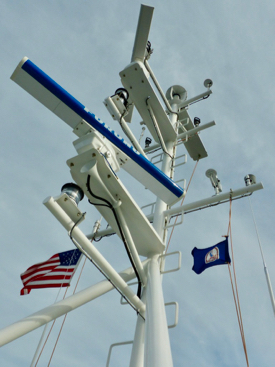 “The dynamic positioning system maximizes our data accuracy,” says Wells. “Many of our long-term surveys require that the vessel return to the same sampling station month after month and year after year to avoid bias in the findings; the Virginia’s state-of-the-art propulsion and navigational systems will ensure that we can do this as precisely and accurately as possible.”
“The dynamic positioning system maximizes our data accuracy,” says Wells. “Many of our long-term surveys require that the vessel return to the same sampling station month after month and year after year to avoid bias in the findings; the Virginia’s state-of-the-art propulsion and navigational systems will ensure that we can do this as precisely and accurately as possible.”
When not in use by research teams from VIMS, the Virginia will be available for charter by external parties as well. The vessel offers opportunities for internal and external environmental research related to offshore sand and mineral resources, offshore energy, and dredging and maintenance of navigational channels.
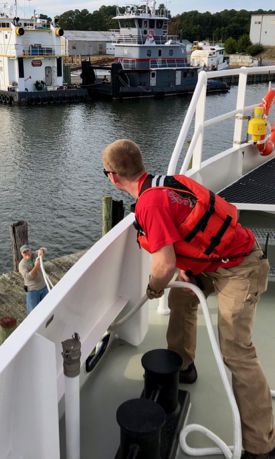 Designed by JMS Naval Architects of Mystic, Connecticut, and built in Canada by Méridien Maritime Réparation, the Virginia replaces the 65-foot R/V Bay Eagle, a converted oil-rig tender that has been in service at VIMS since 1987. The Bay Eagle will be retired after a year of side-by-side comparison tows to identify and correct for any bias in long-term monitoring results occasioned by the switch to the new vessel.
Designed by JMS Naval Architects of Mystic, Connecticut, and built in Canada by Méridien Maritime Réparation, the Virginia replaces the 65-foot R/V Bay Eagle, a converted oil-rig tender that has been in service at VIMS since 1987. The Bay Eagle will be retired after a year of side-by-side comparison tows to identify and correct for any bias in long-term monitoring results occasioned by the switch to the new vessel.
Homeport for the Virginia is the Ampro Shipyard & Diesel in Weems, Virginia, which offers a 50-ton crane for loading and unloading of large equipment and a host of other amenities. The shipyard lies on Carters Cove on the Rappahannock River, a major tributary of the Chesapeake Bay.


